Strategic Structural Control of Polyserotonin Nanoparticles and Their Application as pH-Responsive Nanomotors
Abstract
:1. Introduction
2. Materials and Methods
2.1. Materials
2.2. Synthesis of PST Nanoparticles
2.3. Synthesis of CeO2 Nanoenzymes
2.4. Synthesis of CeO2@PST Nanomotors
2.5. Motion Tests of the CeO2@PST Nanomotors
2.6. Characterizations
3. Results and Discussion
3.1. Preparation and Characterization of Anisotropic Mesoporous Bowl-like PST Nanoparticles
3.2. Structural Evolution and Formation Mechanism of Anisotropic Mesoporous Bowl-like PST Nanoparticles
3.3. Synthesis and Characterization of CeO2@PST Nanomotors
3.4. Autonomous Movement of CeO2@PST Nanomotors at the Physiological H2O2 Concentrations
3.5. Responsive Motion Behaviors of CeO2@PST Nanomotors in the Physiological pH Regions
4. Conclusions
Supplementary Materials
Author Contributions
Funding
Data Availability Statement
Conflicts of Interest
References
- Zhou, C.; Yang, L.; Wu, Y.; Yang, M.; He, Q. A Chemotactic Colloidal Motor. Chemistry 2022, 28, e202202319. [Google Scholar] [CrossRef]
- Lv, J.; Xing, Y.; Xu, T.; Zhang, X.; Du, X. Advanced Micro/Nanomotors for Enhanced Bioadhesion and Tissue Penetration. Appl. Mater. Today 2021, 23, 101034. [Google Scholar] [CrossRef]
- Wang, S.; Xu, J.; Zhou, Q.; Geng, P.; Wang, B.; Zhou, Y.; Liu, K.; Peng, F.; Tu, Y. Biodegradability of Micro/Nanomotors: Challenges and Opportunities. Adv. Healthc. Mater. 2021, 10, e2100335. [Google Scholar] [CrossRef] [PubMed]
- Fernández-Medina, M.; Ramos-Docampo, M.A.; Hovorka, O.; Salgueiriño, V.; Städler, B. Recent Advances in Nano- and Micromotors. Adv. Funct. Mater. 2020, 30, 1908283. [Google Scholar] [CrossRef]
- Zhang, J.; Chen, Z.; Kankala, R.K.; Wang, S.-B.; Chen, A.-Z. Self-Propelling Micro-/Nano-Motors: Mechanisms, Applications, and Challenges in Drug Delivery. Int. J. Pharm. 2021, 596, 120275. [Google Scholar] [CrossRef] [PubMed]
- Xu, W.; Qin, H.; Tian, H.; Liu, L.; Gao, J.; Peng, F.; Tu, Y. Biohybrid Micro/Nanomotors for Biomedical Applications. Appl. Mater. Today 2022, 27, 101482. [Google Scholar] [CrossRef]
- Gao, C.; Wang, Y.; Ye, Z.; Lin, Z.; Ma, X.; He, Q. Biomedical Micro-/Nanomotors: From Overcoming Biological Barriers to In Vivo Imaging. Adv. Mater. 2021, 33, e2000512. [Google Scholar] [CrossRef]
- Wan, M.; Li, T.; Chen, H.; Mao, C.; Shen, J. Biosafety, Functionalities, and Applications of Biomedical Micro/Nanomotors. Angew. Chem. 2021, 133, 13266–13284. [Google Scholar] [CrossRef]
- Mathesh, M.; Sun, J.; Van Der Sandt, F.; Wilson, D.A. Supramolecular Nanomotors with “pH Taxis” for Active Drug Delivery in the Tumor Microenvironment. Nanoscale 2020, 12, 22495–22501. [Google Scholar] [CrossRef]
- Pan, Y.; Ma, X.; Wu, Y.; Zhao, Z.; He, Q.; Ji, Y. pH-Responsive Glucose-Powered Janus Polymer Brushes Nanomotors for Drug Delivery and Controlled Release. Colloids Surf. A Physicochem. Eng. Asp. 2024, 684, 133070. [Google Scholar] [CrossRef]
- Chen, Z.; Xia, T.; Zhang, Z.; Xie, S.; Wang, T.; Li, X. Enzyme-Powered Janus Nanomotors Launched from Intratumoral Depots to Address Drug Delivery Barriers. Chem. Eng. J. 2019, 375, 122109. [Google Scholar] [CrossRef]
- Karaca, G.Y.; Kuralay, F.; Uygun, E.; Ozaltin, K.; Demirbuken, S.E.; Garipcan, B.; Oksuz, L.; Oksuz, A.U. Gold-Nickel Nanowires as Nanomotors for Cancer Marker Biodetection and Chemotherapeutic Drug Delivery. ACS Appl. Nano Mater. 2021, 4, 3377–3388. [Google Scholar] [CrossRef]
- Wu, Y.; Song, Z.; Deng, G.; Jiang, K.; Wang, H.; Zhang, X.; Han, H. Gastric Acid Powered Nanomotors Release Antibiotics for In Vivo Treatment of Helicobacter Pylori Infection. Small 2021, 17, e2006877. [Google Scholar] [CrossRef] [PubMed]
- Tong, F.; Liu, J.; Luo, L.; Qiao, L.; Wu, J.; Wu, G.; Mei, Q. PH/ROS-Responsive Propelled Nanomotors for the Active Treatment of Renal Injury. Nanoscale 2023, 15, 6745–6758. [Google Scholar] [CrossRef] [PubMed]
- Ji, Y.; Pan, Y.; Ma, X.; Ma, Y.; Zhao, Z.; He, Q. PH-Sensitive Glucose-Powered Nanomotors for Enhanced Intracellular Drug Delivery and Ferroptosis Efficiency. Chem. Asian J. 2024, 19, e202300879. [Google Scholar] [CrossRef] [PubMed]
- Ren, J.; Hu, P.; Ma, E.; Zhou, X.; Wang, W.; Zheng, S.; Wang, H. Enzyme-Powered Nanomotors with Enhanced Cell Uptake and Lysosomal Escape for Combined Therapy of Cancer. Appl. Mater. Today 2022, 27, 101445. [Google Scholar] [CrossRef]
- Gao, T.; Lin, J.; Xu, L.; Guan, J. Self-Adaptive Flask-like Nanomotors Based on Fe3O4 Nanoparticles to a Physiological PH. Nanomaterials 2022, 12, 2049. [Google Scholar] [CrossRef]
- Žiemytė, M.; Escudero, A.; Díez, P.; Ferrer, M.D.; Murguía, J.R.; Martí-Centelles, V.; Mira, A.; Martínez-Máñez, R. Ficin-Cyclodextrin-Based Docking Nanoarchitectonics of Self-Propelled Nanomotors for Bacterial Biofilm Eradication. Chem. Mater. 2023, 35, 4412–4426. [Google Scholar] [CrossRef]
- Ramos Docampo, M.A.; Qian, X.; Ade, C.; Floriano Marcelino, T.; Ceccato, M.; Foss, M.; Hovorka, O.; Städler, B. PH-Responsive Motors and Their Interaction with RAW 264.7 Macrophages. Adv. Mater. Interfaces 2023, 10, 2201509. [Google Scholar] [CrossRef]
- Ligneul, R.; Mainen, Z.F. Serotonin. Curr. Biol. 2023, 33, R1216–R1221. [Google Scholar] [CrossRef] [PubMed]
- Salvan, P.; Fonseca, M.; Winkler, A.M.; Beauchamp, A.; Lerch, J.P.; Johansen-Berg, H. Serotonin Regulation of Behavior via Large-Scale Neuromodulation of Serotonin Receptor Networks. Nat. Neurosci. 2023, 26, 53–63. [Google Scholar] [CrossRef] [PubMed]
- Wang, Y.; Chen, Y.; Zhang, A.; Chen, K.; Ouyang, P. Advances in the Microbial Synthesis of the Neurotransmitter Serotonin. Appl. Microbiol. Biotechnol. 2023, 107, 4717–4725. [Google Scholar] [CrossRef] [PubMed]
- Musabirova, G.; Engberg, O.; Gupta, A.; Roy, D.S.; Maiti, S.; Huster, D. Serotonergic Drugs Modulate the Phase Behavior of Complex Lipid Bilayers. Biochimie 2022, 203, 40–50. [Google Scholar] [CrossRef] [PubMed]
- Balakrishna, P.; George, S.; Hatoum, H.; Mukherjee, S. Serotonin Pathway in Cancer. Int. J. Mol. Sci. 2021, 22, 1268. [Google Scholar] [CrossRef] [PubMed]
- Meng, Y.; Zhu, J.; Ding, J.; Zhou, W. Polyserotonin as a Versatile Coating with pH-Responsive Degradation for Anti-Tumor Therapy. Chem. Commun. 2022, 58, 6713–6716. [Google Scholar] [CrossRef]
- Nakatsuka, N.; Hasani-Sadrabadi, M.M.; Cheung, K.M.; Young, T.D.; Bahlakeh, G.; Moshaverinia, A.; Weiss, P.S.; Andrews, A.M. Polyserotonin Nanoparticles as Multifunctional Materials for Biomedical Applications. ACS Nano 2018, 12, 4761–4774. [Google Scholar] [CrossRef]
- Ishino, K.; Nishitani, S.; Man, Y.; Saito, A.; Sakata, T. Surface Characteristics and Formation of Polyserotonin Thin Films for Bioelectrical and Biocompatible Interfaces. Langmuir 2022, 38, 8633–8642. [Google Scholar] [CrossRef]
- Ezati, N.; Abdouss, M.; Rouhani, M.; Kerr, P.G.; Kowsari, E. Novel Serotonin Decorated Molecularly Imprinted Polymer Nanoparticles Based on Biodegradable Materials; A Potential Self-Targeted Delivery System for Irinotecan. React. Funct. Polym. 2022, 181, 105437. [Google Scholar] [CrossRef]
- Guan, B.Y.; Yu, L.; Lou, X.W. Formation of Asymmetric Bowl-Like Mesoporous Particles via Emulsion-Induced Interface Anisotropic Assembly. J. Am. Chem. Soc. 2016, 138, 11306–11311. [Google Scholar] [CrossRef]
- Guan, B.Y.; Zhang, S.L.; Lou, X.W. Realization of Walnut-Shaped Particles with Macro-/Mesoporous Open Channels through Pore Architecture Manipulation and Their Use in Electrocatalytic Oxygen Reduction. Angew. Chem. 2018, 130, 6284–6288. [Google Scholar] [CrossRef]
- Sardoiwala, M.N.; Nagpal, S.; Bhatt, B.; Roy Choudhury, S.; Karmakar, S. Improved Melatonin Delivery by a Size-Controlled Polydopamine Nanoformulation Attenuates Preclinical Diabetic Retinopathy. Mol. Pharm. 2023, 20, 2899–2910. [Google Scholar] [CrossRef] [PubMed]
- Forman, H.J.; Bernardo, A.; Davies, K.J.A. What Is the Concentration of Hydrogen Peroxide in Blood and Plasma? Arch. Biochem. Biophys. 2016, 603, 48–53. [Google Scholar] [CrossRef] [PubMed]
- Huang, C.; Xu, J.; Li, J.; He, S.; Xu, H.; Ren, X.; Singh, V.; Wu, L.; Zhang, J. Hydrogen Peroxide Responsive Covalent Cyclodextrin Framework for Targeted Therapy of Inflammatory Bowel Disease. Carbohydr. Polym. 2022, 285, 119252. [Google Scholar] [CrossRef]
- Zhang, Y.; Zhang, J.; Jia, Q.; Ge, J.; Wang, P. Innovative Strategies of Hydrogen Peroxide-Involving Tumor Therapeutics. Mater. Chem. Front. 2021, 5, 4474–4501. [Google Scholar] [CrossRef]
- Lin, B.; Chen, H.; Liang, D.; Lin, W.; Qi, X.; Liu, H.; Deng, X. Acidic PH and High-H2O2 Dual Tumor Microenvironment-Responsive Nanocatalytic Graphene Oxide for Cancer Selective Therapy and Recognition. ACS Appl. Mater. Interfaces 2019, 11, 11157–11166. [Google Scholar] [CrossRef]
- Winterbourn, C.C. Reconciling the Chemistry and Biology of Reactive Oxygen Species. Nat. Chem. Biol. 2008, 4, 278–286. [Google Scholar] [CrossRef] [PubMed]
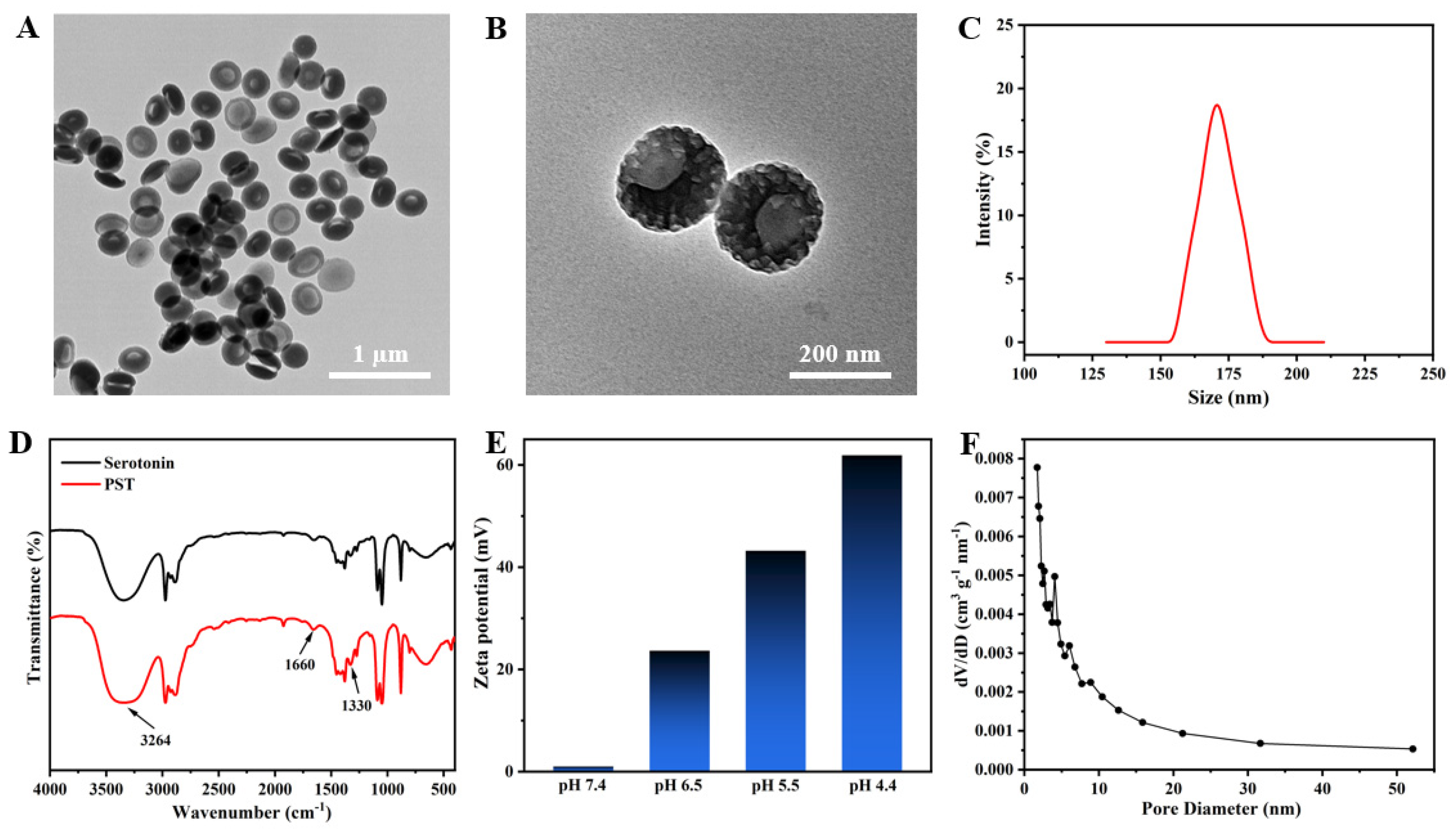
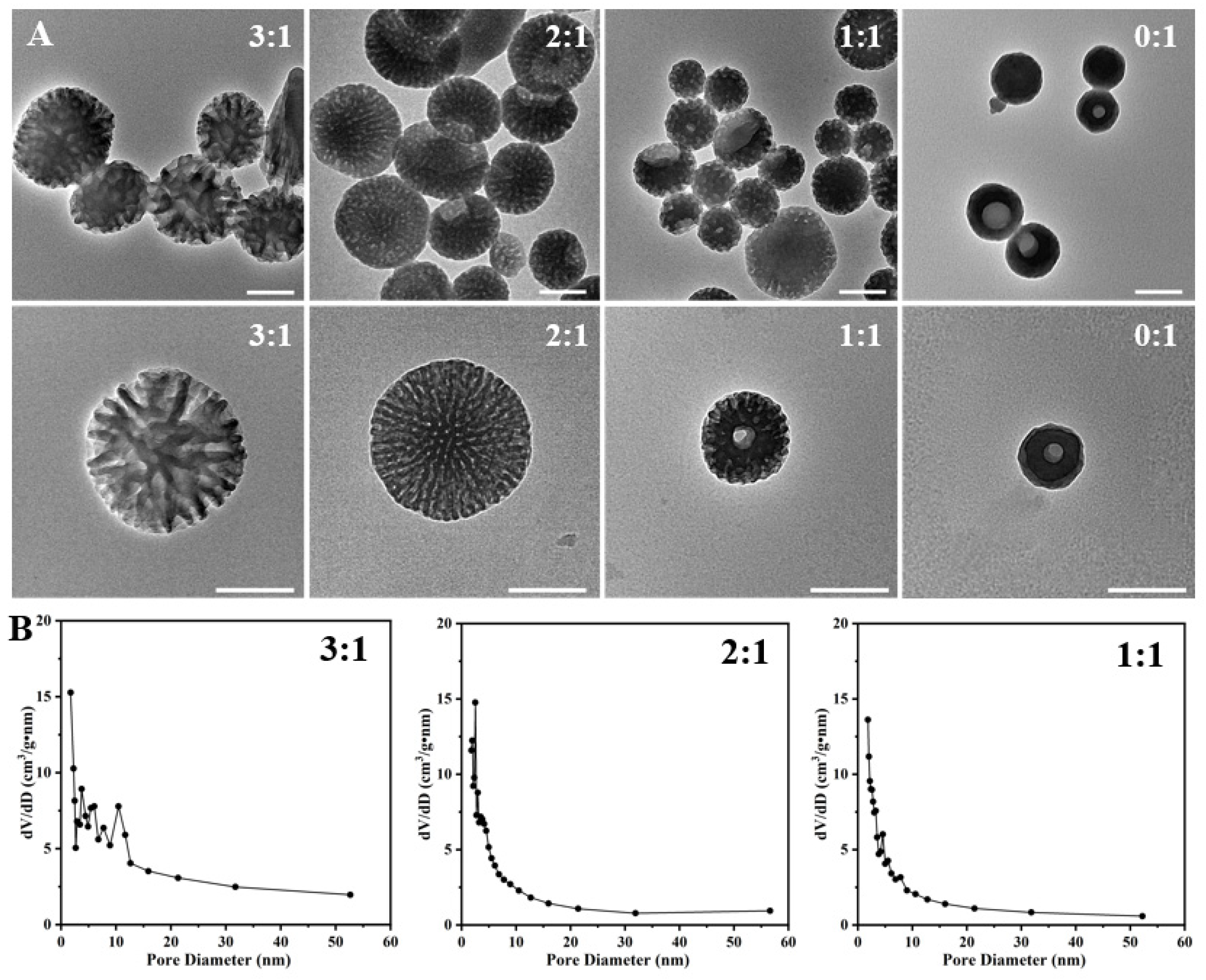
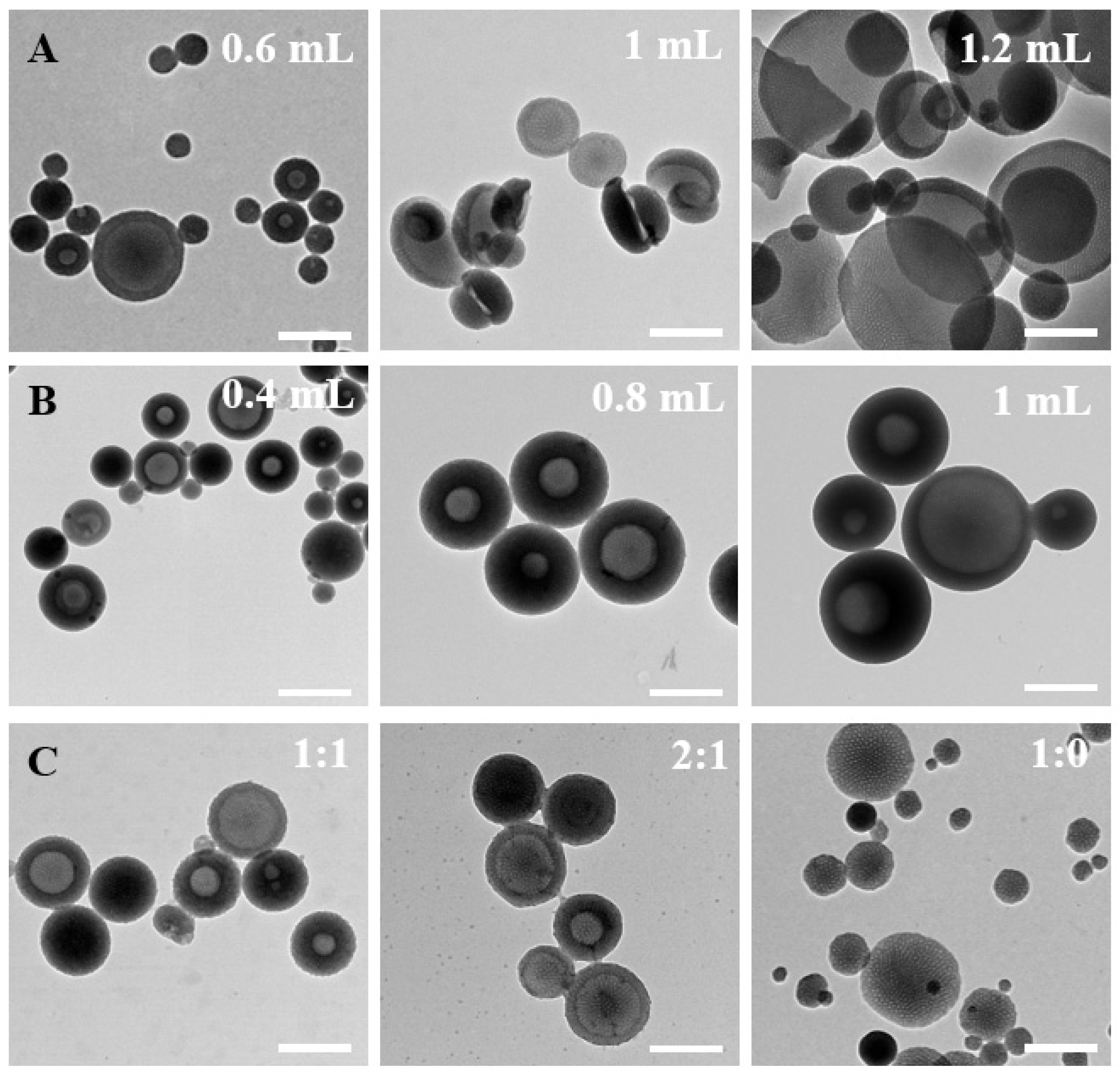
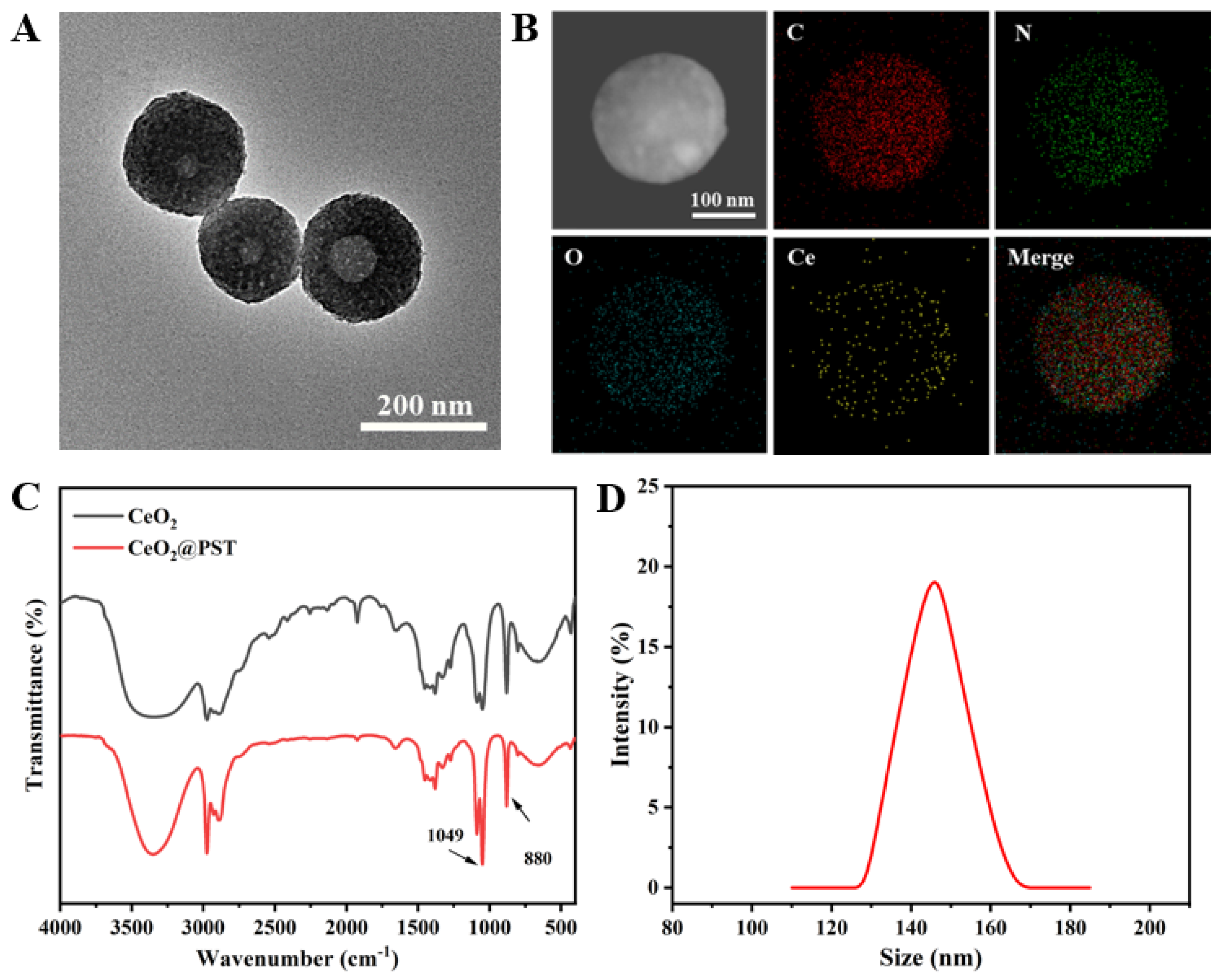

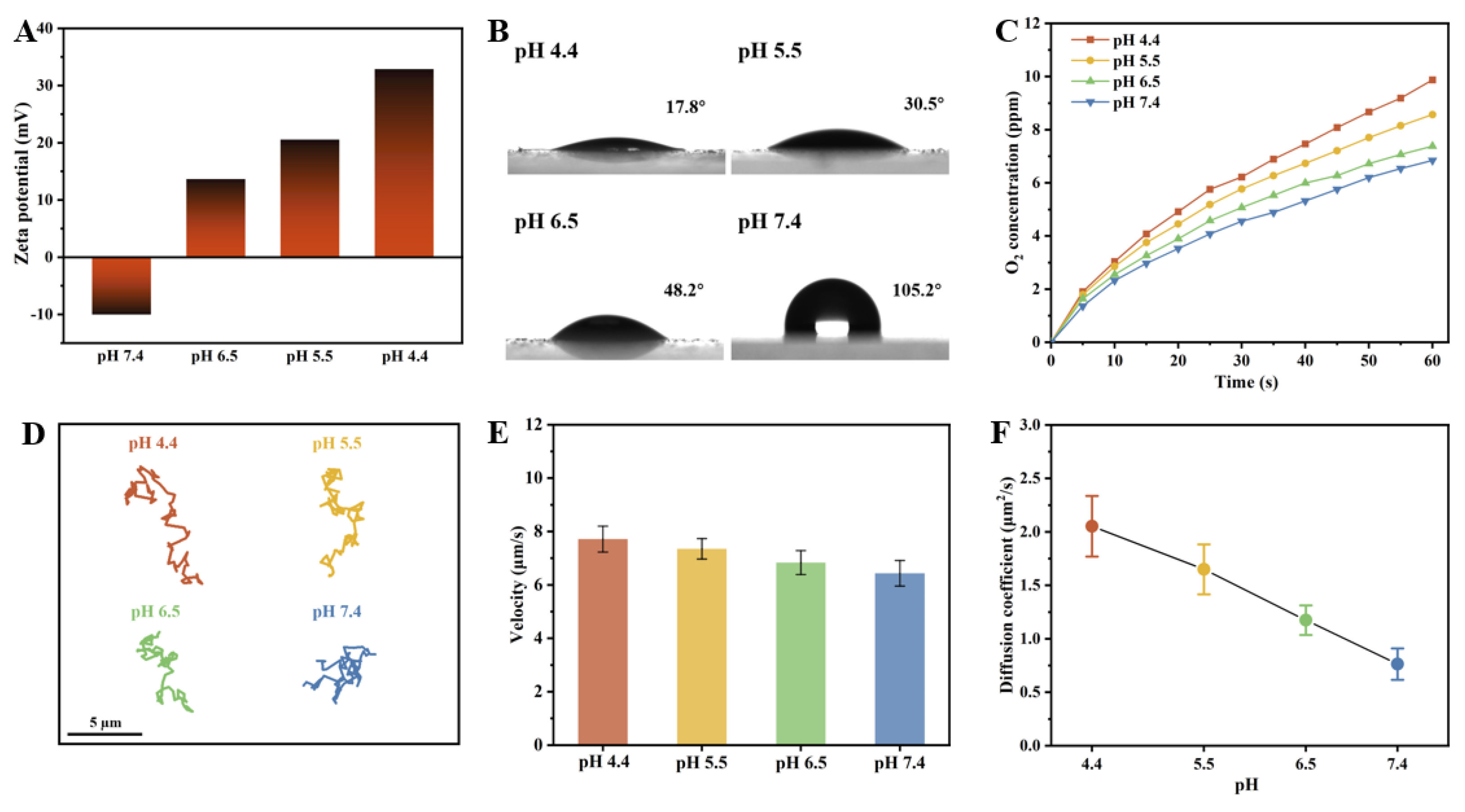
Disclaimer/Publisher’s Note: The statements, opinions and data contained in all publications are solely those of the individual author(s) and contributor(s) and not of MDPI and/or the editor(s). MDPI and/or the editor(s) disclaim responsibility for any injury to people or property resulting from any ideas, methods, instructions or products referred to in the content. |
© 2024 by the authors. Licensee MDPI, Basel, Switzerland. This article is an open access article distributed under the terms and conditions of the Creative Commons Attribution (CC BY) license (https://creativecommons.org/licenses/by/4.0/).
Share and Cite
Hu, J.; Cao, J.; Lin, J.; Xu, L. Strategic Structural Control of Polyserotonin Nanoparticles and Their Application as pH-Responsive Nanomotors. Nanomaterials 2024, 14, 519. https://doi.org/10.3390/nano14060519
Hu J, Cao J, Lin J, Xu L. Strategic Structural Control of Polyserotonin Nanoparticles and Their Application as pH-Responsive Nanomotors. Nanomaterials. 2024; 14(6):519. https://doi.org/10.3390/nano14060519
Chicago/Turabian StyleHu, Junyi, Jingjing Cao, Jinwei Lin, and Leilei Xu. 2024. "Strategic Structural Control of Polyserotonin Nanoparticles and Their Application as pH-Responsive Nanomotors" Nanomaterials 14, no. 6: 519. https://doi.org/10.3390/nano14060519



